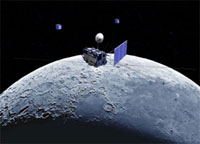Japan's lunar probe reaches Moon orbit

The most ambitious mission to study Earth's nearest neighbor since the U.S. Apollo project flourishes - Japan 's first lunar satellite successfully moved into orbit Friday.
Japan's space agency said the probe, named after a folklore princess, was in high orbit over the moon and all was going well as it began a yearlong project to map and study the lunar surface.
The announcement marks a major step forward for Japan, which was once considered the leading space-faring nation in Asia but is now struggling to keep up with rival China.
In an increasingly heated Asian space race, both China and India plan lunar probes of their own - China's could be launched in the next few months, while India's is to blast off next April. Friday's announcement, ironically, came one day after the 50th anniversary of the launch of the Russian Sputnik satellite, which marked the beginning of the race to the moon between the Soviet Union and the United States.
Japanese officials claim the 32-billion yen (US$279 million; EUR201 million) Selenological and Engineering Explorer - or SELENE - is the largest lunar mission since the U.S. Apollo program of the 1960s and 70s in terms of overall scope and ambition, outpacing the former Soviet Union's Luna program and NASA's Clementine and Lunar Prospector projects.
"We believe this is a big step," said project manager Yoshisada Takizawa. "Everything is going well and we are confident."
The mission, which was delayed for four years, involves placing the main satellite - called "Kaguya," after a legendary moon princess - in a circular orbit at an altitude of about 100 kilometers (60 miles) and deploying two smaller satellites in elliptical orbits, according to the Japan Aerospace Exploration Agency, or JAXA.
The data they send back will be used for mapping the moon and studying its origin and evolution. Takizawa said it will begin its observation phase in mid- to late-December.
"The timing was very delicate," he said at a news conference in JAXA's Tokyo headquarters via a video link from the mission command center south of the capital. "It was important to the completion of the mission, and it was successful."
Japan launched its first satellite in 1970 and has marked several major scientific coups in space _ including a probe that made a rendezvous with an asteroid. Its domestically produced H-2A rocket is one of the world's most advanced and consistent.
But it has also been beset by delays and mishaps.
Earlier this year, one of its four spy satellites became unresponsive due to apparent electrical problems. The other three satellites were functioning normally, but the failure left its multibillion dollar (euro), long-awaited spy network with a significant hole.
Two years ago, a mission to Mars had to be abandoned after the probe moved off course, and a probe that neared an asteroid was supposed to bring back surface samples but is now lost in space. In January, JAXA gave up on a mission to land on the moon's surface. The Lunar-A probe, originally scheduled to lift off in 1995, was to plant two seismic sensors on the lunar surface, but development of the penetrator probes took so long the mission's mother ship fell into disrepair.
China, meanwhile, has made major gains.
Though no date has been formally set, China is planning to launch its own lunar "by the end of the year." The Chang'e 1 orbiter will use stereo cameras and X-ray spectrometers to map three-dimensional images of the lunar surface and study its dust.
China sent shock waves through the region in 2003, when it became the first Asian country to put its own astronauts into space. More ominously, China also blasted an old satellite into oblivion with a land-based anti-satellite missile, the first such test ever conducted by any nation, including the United States and Russia.
That test was widely criticized for its military implications. A similar rocket could be used to shoot military satellites out of space, and create a dangerous haze of space debris.
India, meanwhile, also plans a manned space mission by 2015, using indigenous systems and technology. That will be preceded by an unmanned moon mission, Chandrayaan-1, next April.
Japan launched a moon probe in 1990, but that was a flyby mission.
The long-delayed SELINE was launched on Sept. 14 aboard an H-2A from Tanegashima, the remote island where the agency's space center is located. The probe carries sheets engraved with messages from 412,627 people around the world in a "Wish upon the Moon" publicity campaign.
Subscribe to Pravda.Ru Telegram channel, Facebook, RSS!




